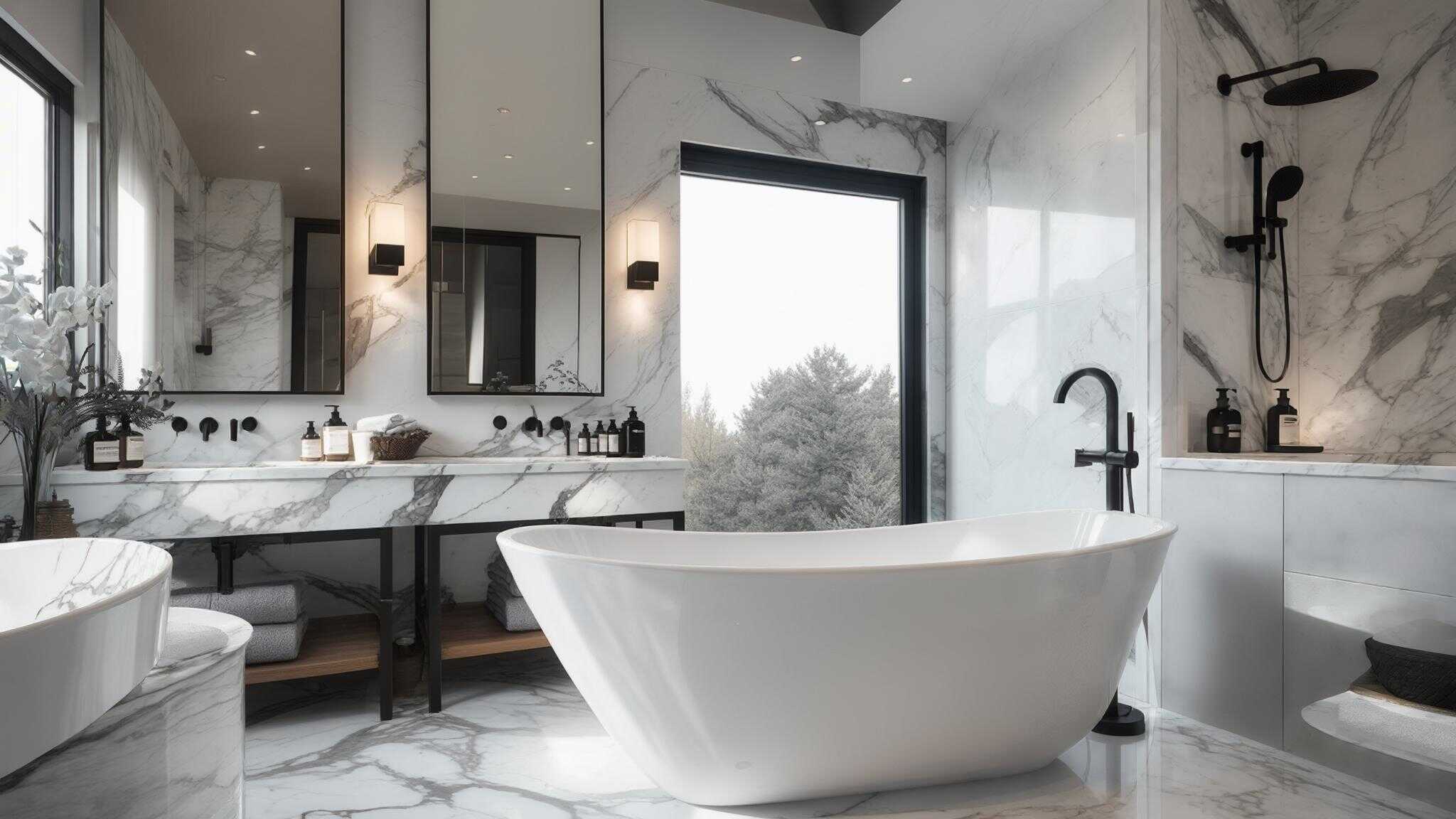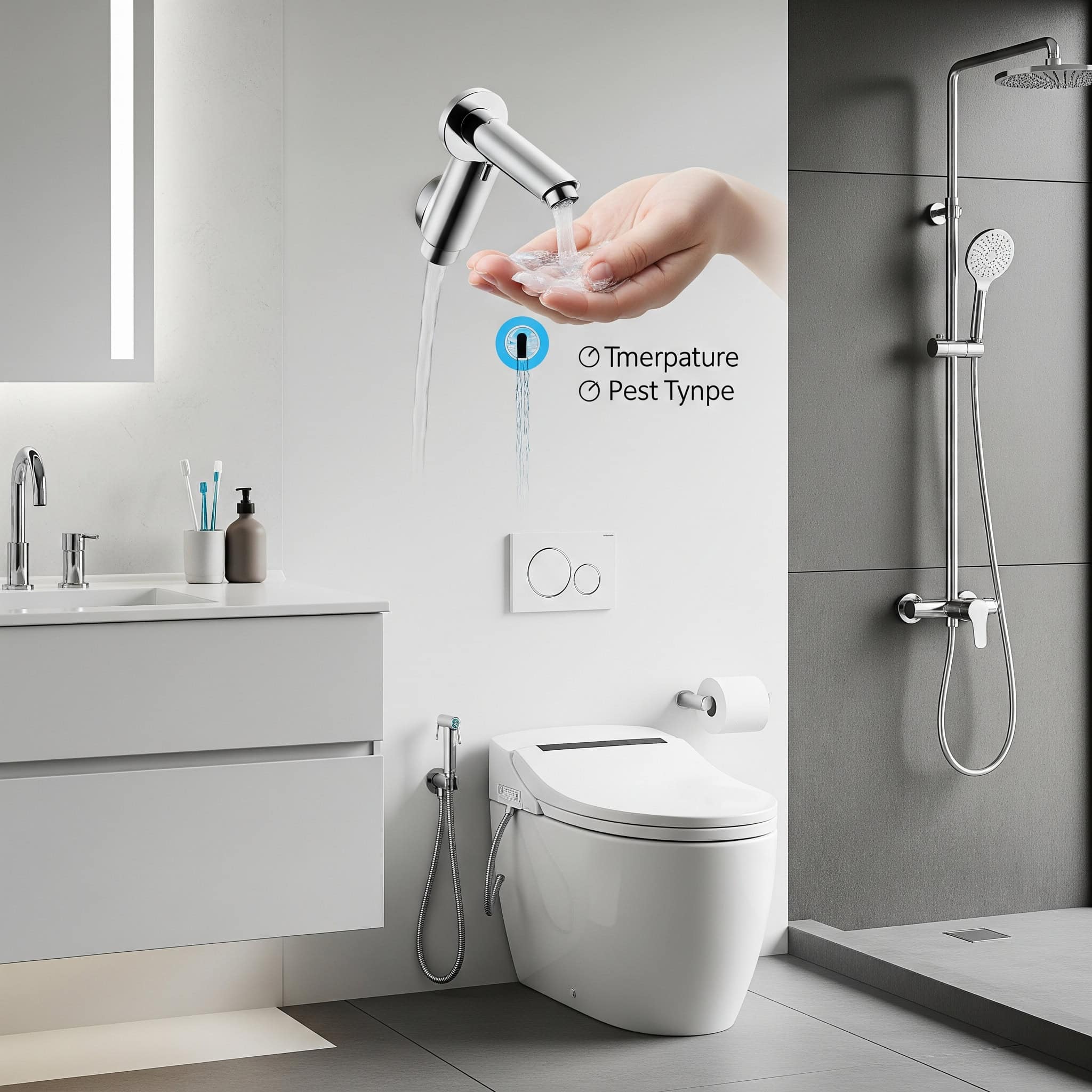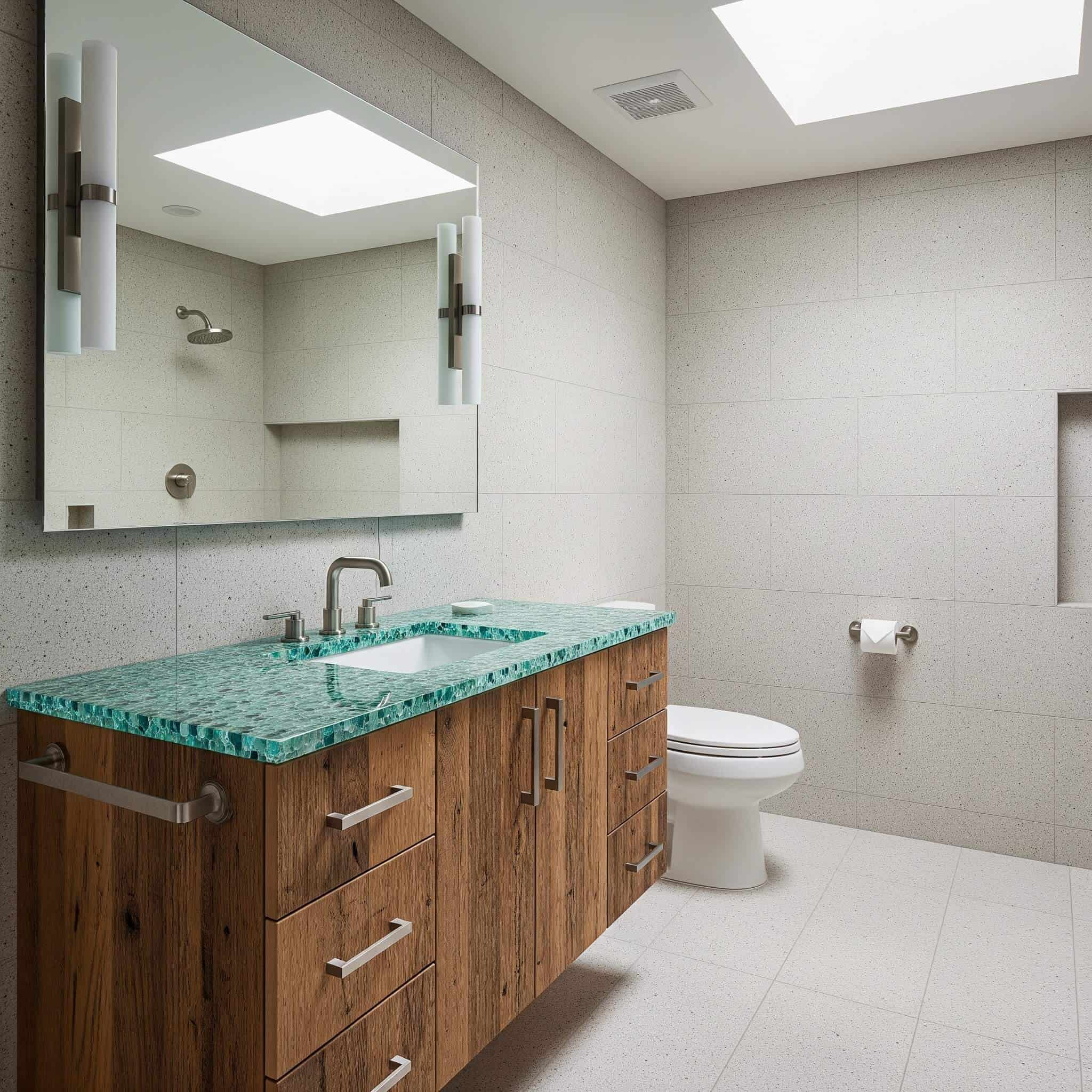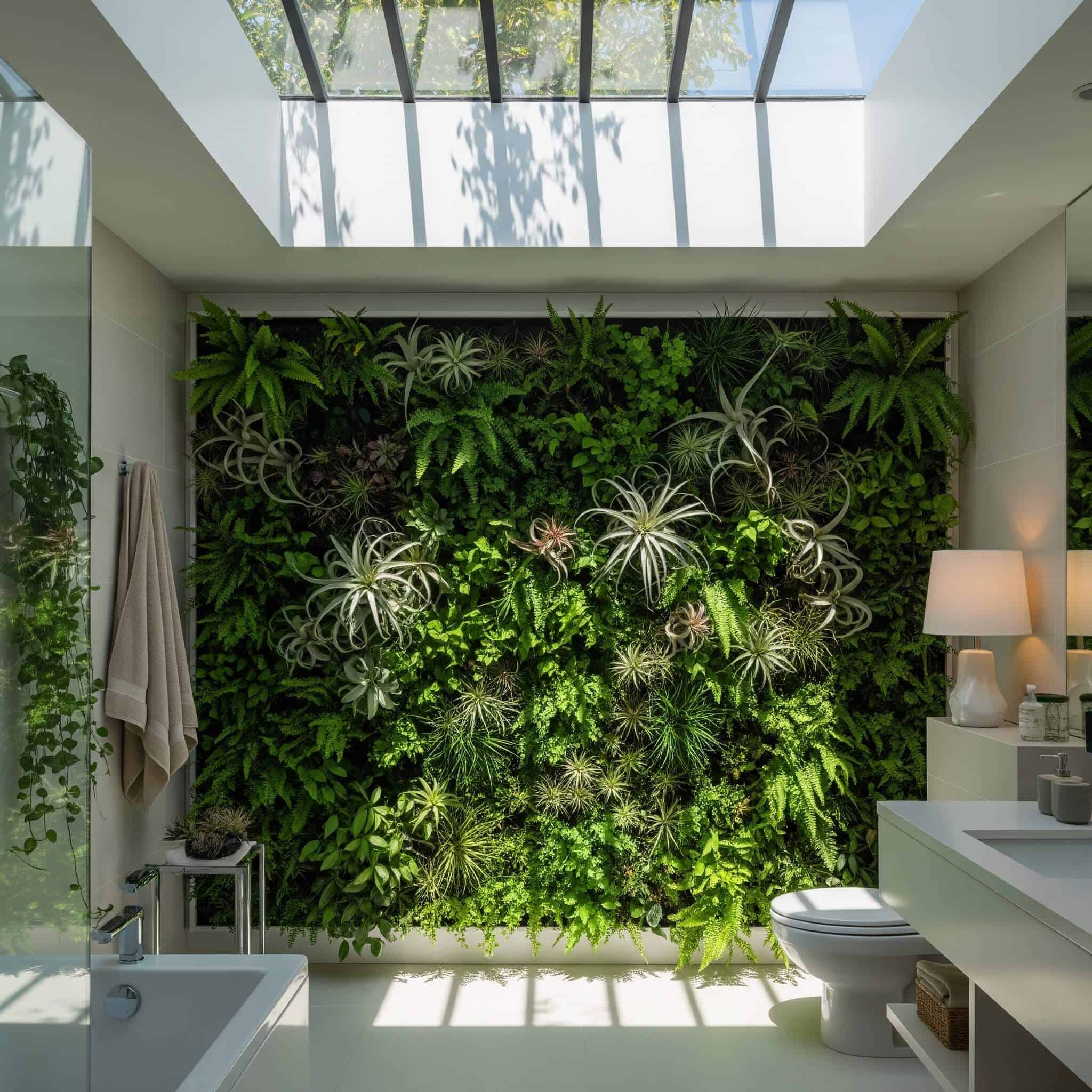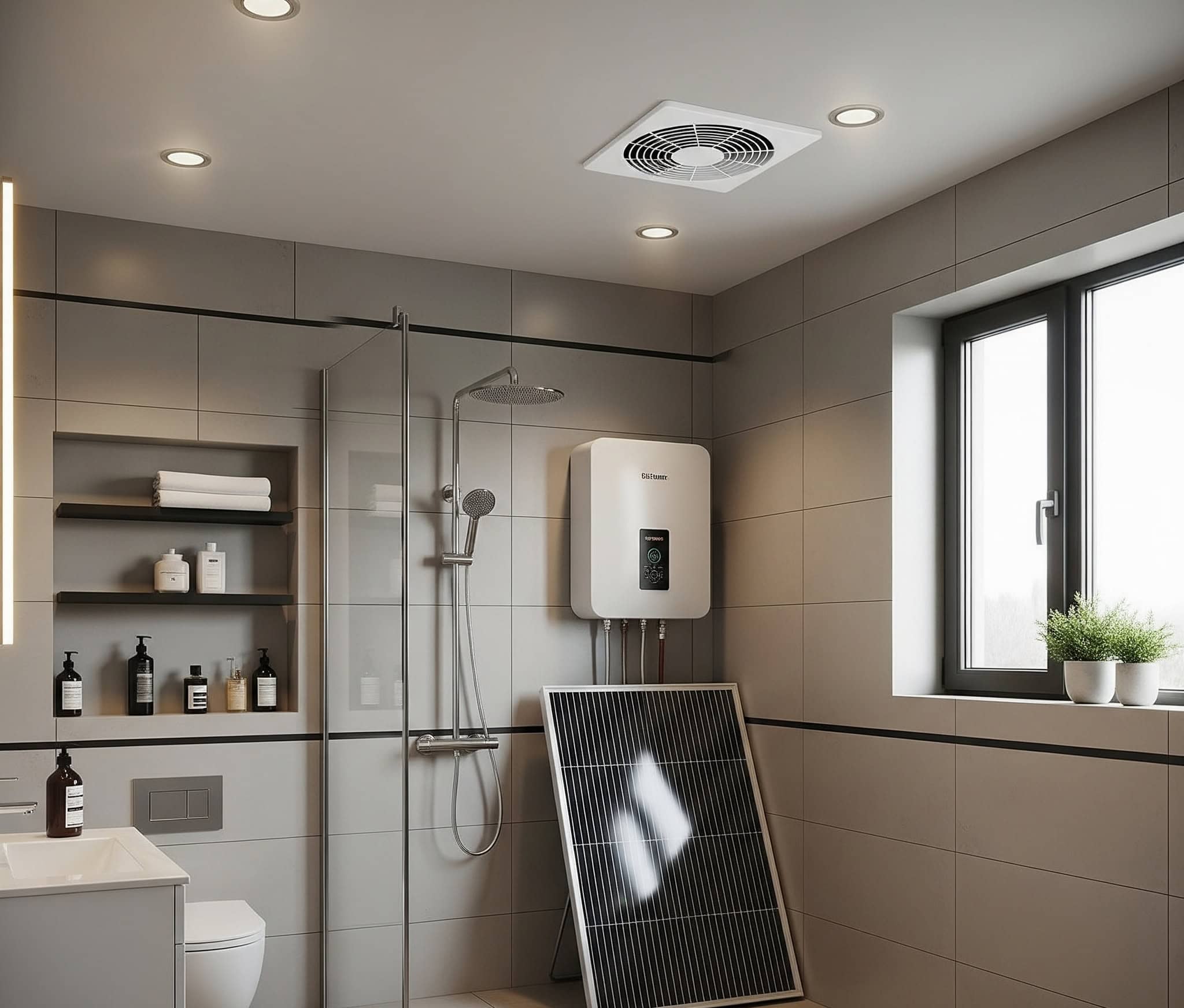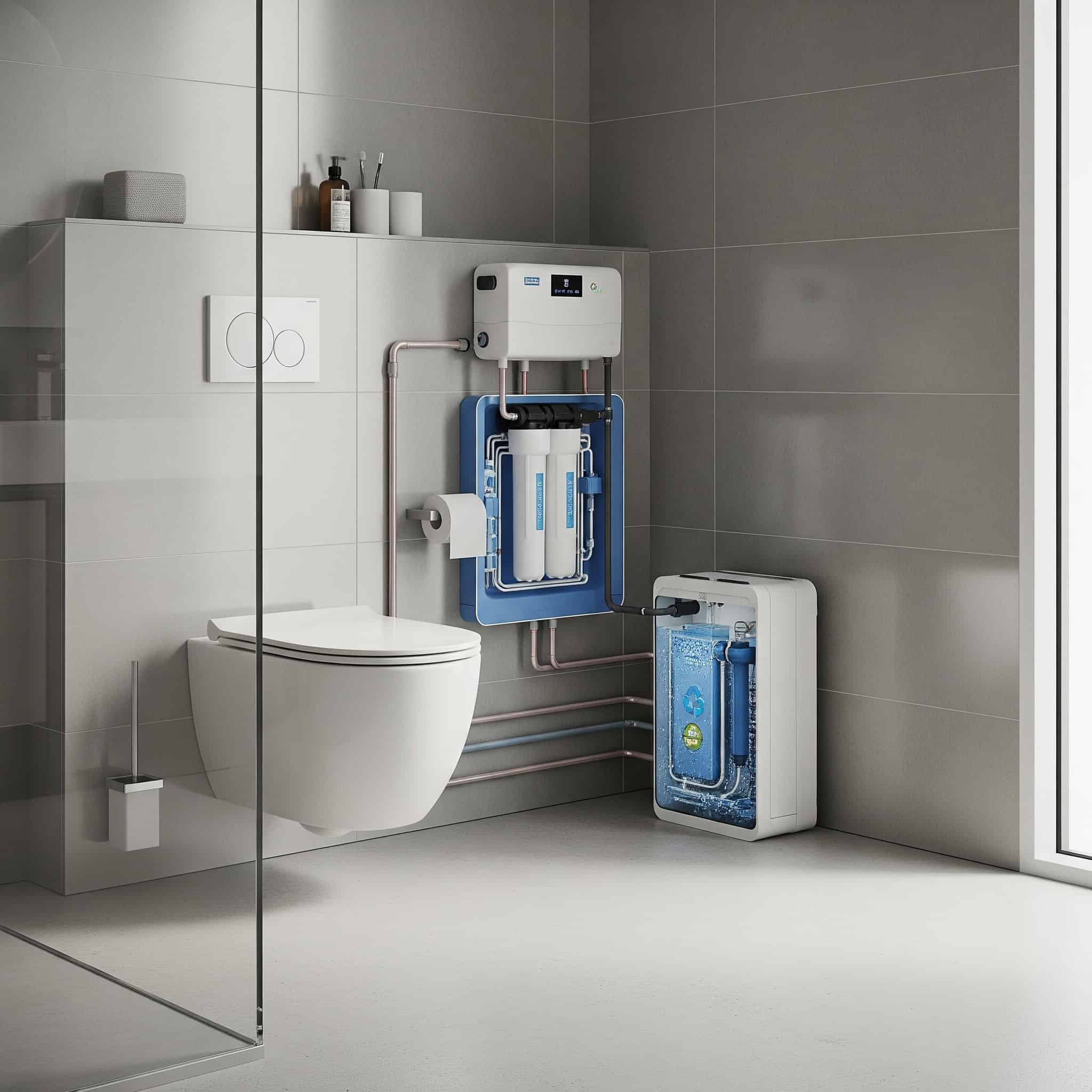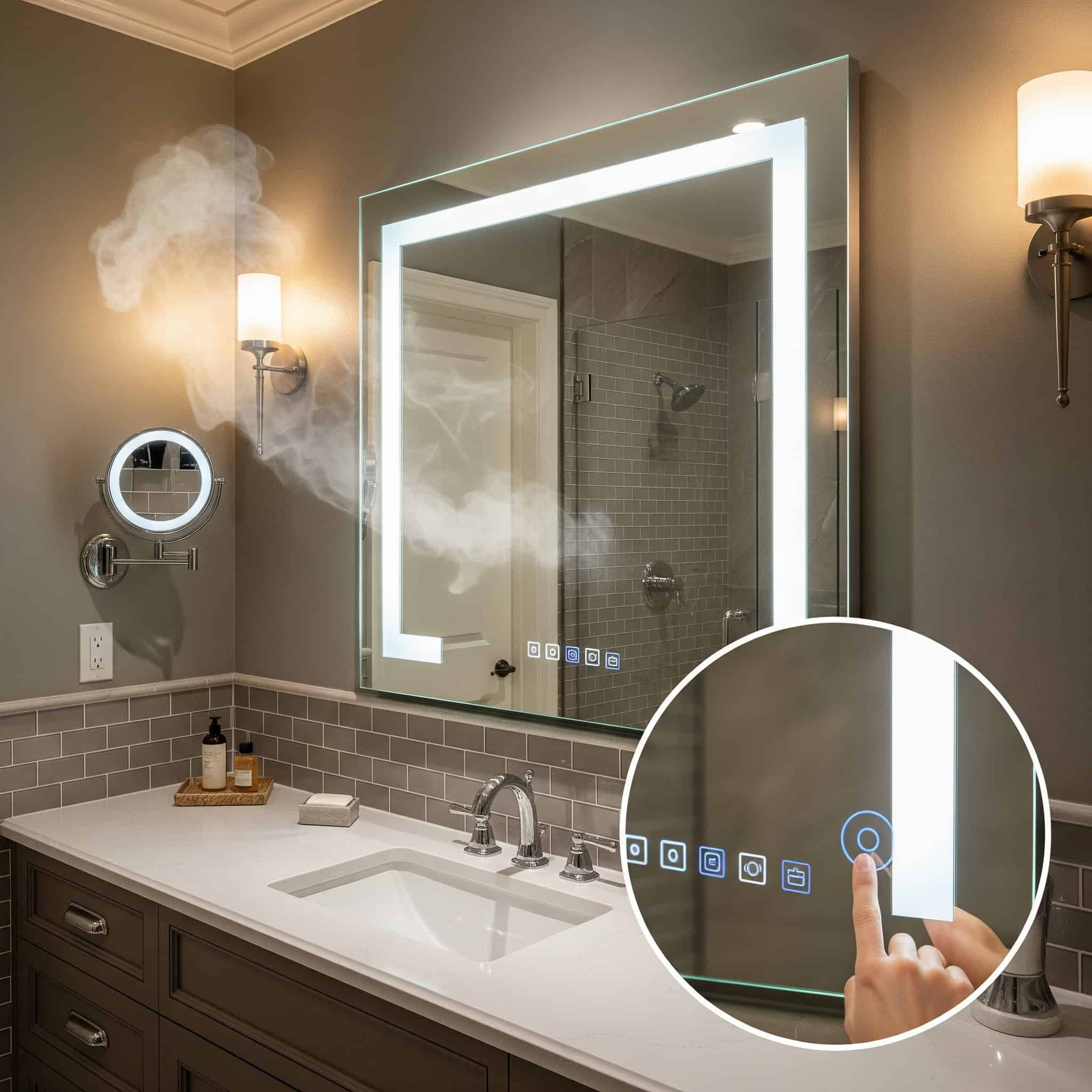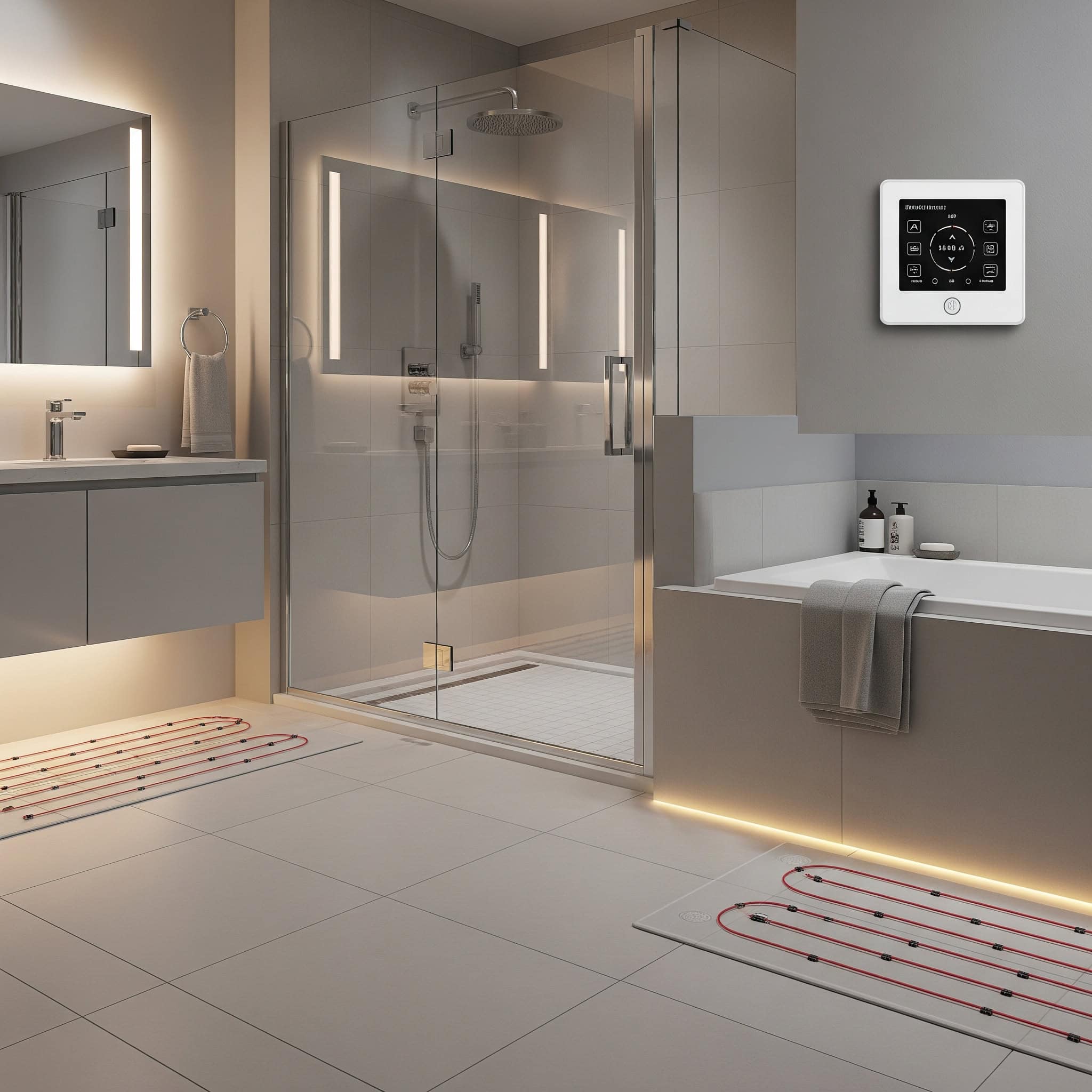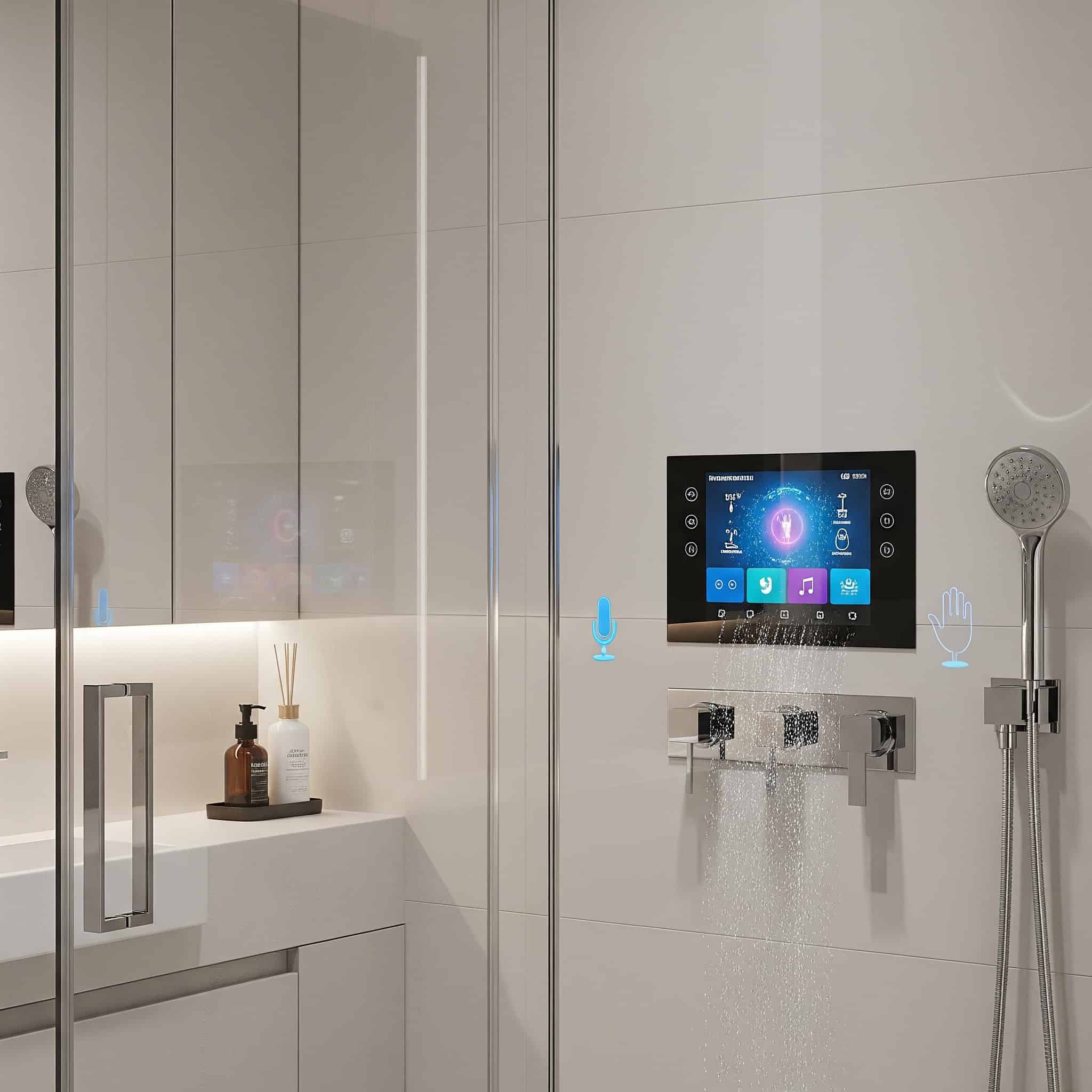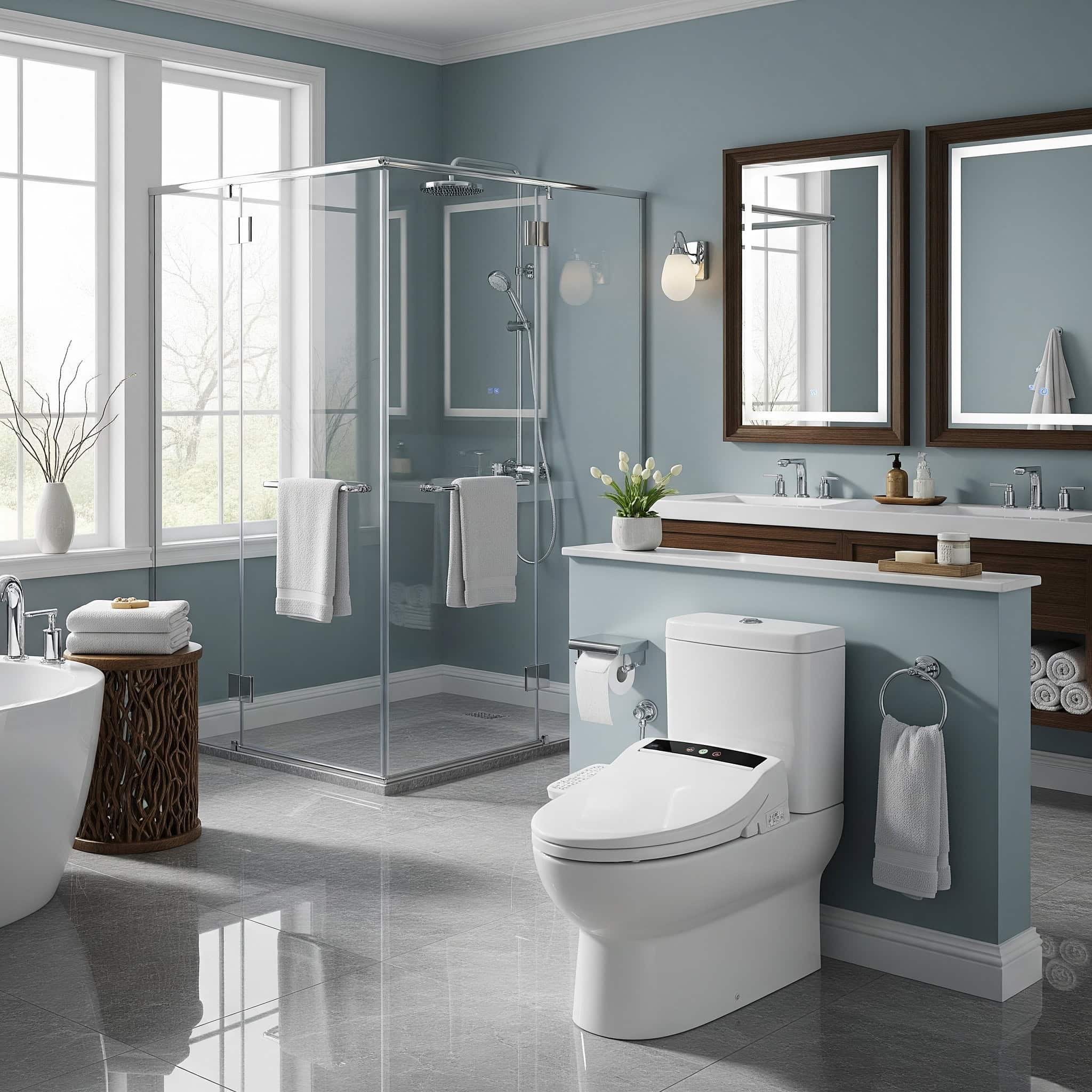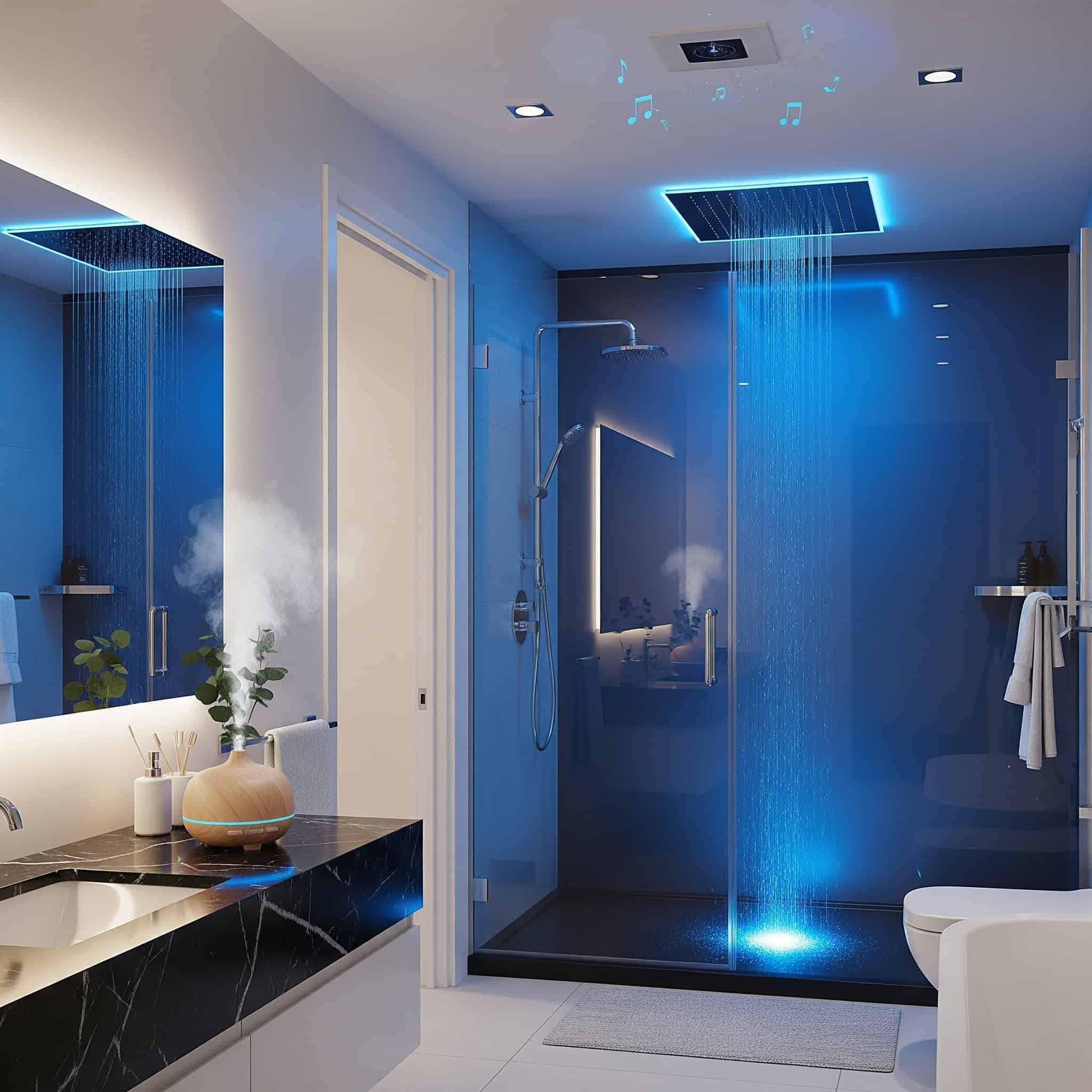25 Stunning Bathroom Ideas for 2025: Transform Your Space with These Top Trends
According to a recent National Kitchen and Bath Association report, homeowners are spending an average of $20,000 on bathroom renovations in 2024, with that number expected to rise in 2025. I’ve been helping clients redesign their bathrooms for over a decade, and I’ve never seen more exciting innovations than what’s coming in 2025. Whether you’re planning a complete bathroom renovation or just want to refresh your space, this comprehensive guide will walk you through the top bathroom ideas for the coming year, with practical considerations for every budget and style preference.
Bathroom renovations consistently rank among the top home improvement projects with an average ROI of 60-67%. This makes them both functionally and financially beneficial investments for homeowners looking to upgrade their spaces.
The bathroom design industry is experiencing rapid technological integration with smart home features growing at a 23% annual rate. This growth is particularly noticeable in moisture-resistant electronics and water conservation systems that are transforming how we interact with our bathrooms.
Table of Contents
-
What to Consider When Looking for Bathroom Ideas
-
Sustainable and Eco-Friendly Bathrooms
-
Technological Innovations
-
Space-Optimizing Solutions
-
Luxury and Wellness Features
-
Timeless Design Elements
-
How Jiffy Junk Can Help With Your Renovation
-
Final Thoughts
What to Consider When Looking for Bathroom Ideas
Before diving into specific bathroom ideas, I need to establish a framework for your project. Your budget will significantly impact what’s possible, typically ranging from 5-10% of your home’s value for a full bathroom remodel with an additional 20% set aside for contingencies. Space constraints will dictate design possibilities, while functionality considerations should reflect your daily usage patterns.
Style longevity is crucial for avoiding a dated look, and sustainability features can reduce both environmental impact and utility costs. Be realistic about maintenance requirements, consider potential return on investment, and ensure compliance with local building codes and permit requirements.
When planning your bathroom renovation, be sure to consider how you’ll handle the disposal of old fixtures and materials. Our guide on bathroom demolition challenges explains why professional removal services can save you time and prevent potential injuries during the renovation process.
The average bathroom remodel costs between $10,000-$25,000, with luxury renovations exceeding $50,000. This wide range makes proper budgeting and allocation of funds to priority features essential for project success. You’ll want to identify which elements matter most to you before beginning.
Bathroom ventilation requirements typically mandate a minimum of 50 CFM (cubic feet per minute) for bathrooms under 100 square feet, with larger spaces requiring 1 CFM per square foot. Proper ventilation prevents moisture damage and mold growth, which can quickly undermine even the most beautiful bathroom design.
|
Bathroom Size |
Typical Budget Range |
Best Layout Options |
Key Considerations |
|---|---|---|---|
|
Small (<50 sq ft) |
$5,000-$15,000 |
Corner shower, wall-mounted fixtures, pocket door |
Maximize vertical space, use light colors, consider glass enclosures |
|
Medium (50-100 sq ft) |
$15,000-$30,000 |
Separate shower/tub, standard vanity, toilet alcove |
Balance between storage and open space, potential for double vanity |
|
Large (>100 sq ft) |
$30,000-$50,000+ |
Separate wet areas, double vanity, freestanding tub |
Zoning spaces, luxury features, seating areas |
Sustainable and Eco-Friendly Bathrooms
1. Water-Saving Smart Fixtures
Water conservation is becoming increasingly important, and bathroom fixtures are evolving to meet this need. Touchless faucets can reduce water usage by up to 30%, while dual-flush toilets use 1.28 gallons per flush or less. Smart shower systems offer precise temperature controls and water usage monitoring.
While these fixtures have a higher initial cost than standard options, they can significantly reduce water bills over time and provide excellent sustainability benefits for your bathroom.
WaterSense-labeled fixtures must demonstrate at least 20% greater efficiency than standard fixtures while maintaining performance. Faucet aerators restrict flow to 1.5 gallons per minute compared to the standard 2.2 GPM, making a substantial difference in daily water consumption.
Smart water monitoring systems can detect leaks as small as 1 tablespoon per minute and automatically shut off water supply. These systems potentially save up to 10% on water bills and prevent catastrophic damage from undetected leaks in your bathroom.
2. Recycled and Reclaimed Materials
Incorporating recycled and reclaimed materials into your bathroom design creates unique character while reducing environmental impact. Options include countertops made from recycled glass, reclaimed wood vanities, and tiles made from recycled ceramics or glass.
These materials vary widely in cost but generally offer excellent sustainability credentials. Maintenance requirements depend on the specific material, but most are designed to be durable and long-lasting in bathroom environments.
A client in Portland transformed their outdated bathroom using 100% sustainable materials. They installed a vanity crafted from reclaimed barn wood, paired with a countertop made from recycled glass embedded in concrete. The floor features tiles manufactured from recycled porcelain, while the shower enclosure uses glass panels recycled from office buildings. Not only did this approach create a uniquely textured space with character and history, but it also diverted approximately 300 pounds of material from landfills. The bathroom has maintained its beauty for five years with minimal maintenance beyond standard cleaning and an annual sealing of the concrete countertop.
Recycled glass countertops contain up to 80% post-consumer recycled content and score highly on the Mohs hardness scale (5-7). This makes them resistant to scratches while requiring less energy to produce than virgin materials, perfect for bathroom applications.
Reclaimed wood in bathroom applications requires specialized sealing with marine-grade polyurethane or tung oil. These sealants create a water-resistant barrier that prevents warping and mold growth in high-humidity bathroom environments.
3. Living Walls and Biophilic Design
Bringing nature into the bathroom creates a calming atmosphere while improving air quality. Vertical garden installations with humidity-loving plants, shower-friendly species like ferns and air plants, and maximizing natural light through skylights or larger windows are all effective approaches.
These features require proper ventilation and lighting, along with some maintenance for plant care. The natural air purification and wellness benefits make the effort worthwhile for many bathroom renovations.
Bathroom plants can reduce indoor air pollutants by up to 87% within 24 hours according to NASA research. Species like peace lilies and snake plants are particularly effective at filtering formaldehyde commonly found in bathroom products.
Proper plant integration requires maintaining relative humidity between 40-60% and installing full-spectrum lighting (5000-6500K). This lighting mimics natural daylight for plant photosynthesis while preventing mold growth in your bathroom space.
4. Solar-Powered Bathroom Features
Harnessing solar energy for bathroom features is becoming more accessible and practical. Solar-powered ventilation fans, water heaters for shower systems, and LED lighting powered by small solar panels can significantly reduce energy consumption.
These features require a higher initial investment but offer substantial long-term energy savings. Professional installation is typically necessary, and sufficient sun exposure is essential for optimal functioning in your bathroom.
Solar water heaters can provide up to 80% of a household’s hot water needs with evacuated tube collectors operating efficiently even in cloudy conditions. These systems offer a system efficiency of 70% compared to 20% for photovoltaic panels, making them ideal for bathroom applications.
Integration of micro-inverters with bathroom solar applications allows for modular installation and prevents complete system failure if one component malfunctions. Typical systems are sized between 200-500 watts for bathroom-specific applications, providing reliable power for various features.
5. Greywater Recycling Systems
Water reuse systems are gaining popularity as water conservation becomes more critical. Under-sink water recycling units filter sink water for toilet use, while shower-to-toilet systems repurpose shower water for flushing.
These systems require more extensive plumbing modifications but can reduce bathroom water usage by up to 30%. It’s important to check local building codes, as some areas have restrictions on greywater systems.
If you’re considering eco-friendly options for your bathroom, remember that proper disposal of your old fixtures is just as important for sustainability. Learn more about environmentally responsible approaches in our article on green junk removal to ensure your renovation waste doesn’t end up in landfills.
Residential greywater systems typically employ three-stage filtration: primary screening to remove large particles, secondary biological treatment using beneficial bacteria, and final disinfection often using UV light rather than chemicals. This comprehensive approach ensures water is safe for reuse in your bathroom.
Modern greywater systems incorporate smart monitoring that measures water quality parameters like turbidity and pH. These systems automatically divert water to sewer systems if measurements fall outside safe parameters for reuse, providing peace of mind for bathroom applications.
Technological Innovations
|
Technology |
Average Cost |
Energy Efficiency |
Installation Complexity |
Lifespan |
|---|---|---|---|---|
|
Smart Mirrors |
$700-$2,500 |
Medium (30-60W) |
Moderate (electrical work required) |
5-8 years |
|
Heated Floors |
$16-$20 per sq ft |
High (Energy Star rated systems use 15% less) |
Complex (requires subfloor access) |
15-20 years |
|
Digital Showers |
$1,000-$4,000 |
High (saves up to 30% water) |
Complex (plumbing and electrical) |
10-15 years |
|
Smart Toilets |
$800-$7,000 |
Medium-High (1.28 GPF or less) |
Moderate to Complex |
10-20 years |
|
Chromatherapy |
$500-$1,500 |
Low-Medium (LED based) |
Moderate (requires waterproof connections) |
8-12 years |
6. Smart Mirrors
Smart mirrors are transforming from novelty items to practical bathroom features. These high-tech mirrors include built-in LED lighting, defoggers, Bluetooth speakers, touch-screen capabilities for news and weather updates, and even integrated TVs.
They require electrical connections and possibly Wi-Fi integration. While they come with a higher price point, they add significant convenience and modern appeal to any bathroom design.
Smart mirrors utilize IP65 or higher waterproof ratings to protect electronic components from bathroom humidity. They feature capacitive touch technology that functions even with condensation on the surface, ensuring reliable operation in steamy environments.
Advanced models incorporate anti-fog heating elements that maintain temperatures 10-15°F above dew point. This prevents condensation while consuming only 30-50 watts of power during operation, making them energy-efficient additions to your bathroom.
7. Heated Flooring Systems
Stepping onto a warm floor transforms the bathroom experience, especially during colder months. Electric radiant floor heating mats installed under tile or stone, hydronic systems connected to home heating, and programmable thermostats for energy efficiency are all excellent options.
Installation is best done during a full bathroom remodel. These systems add comfort and can be energy-efficient when properly programmed.
Electric radiant systems operate at 12-15 watts per square foot and can be installed with uncoupling membranes. These membranes prevent tile cracking due to thermal expansion while providing waterproofing benefits for your bathroom floor.
Hydronic systems circulate water at 85-125°F through PEX tubing spaced 6-8 inches apart. They offer more efficient heat transfer than electric systems for larger bathrooms over 100 square feet, making them ideal for master bathroom remodel ideas.
8. Digital Shower Controls
Digital shower systems offer unprecedented control over your shower experience. Touchscreen interfaces provide precise temperature and flow control, while voice-activated systems, programmable settings for different users, and remote start capabilities from smartphone apps add convenience.
These systems require professional installation and may need additional plumbing and electrical work. The higher cost is offset by customization options and water efficiency benefits for your bathroom.
Digital shower systems utilize thermostatic mixing valves that maintain temperature within ±1°F regardless of pressure fluctuations. Digital processors can handle up to 12 gallons per minute for multi-outlet configurations, ensuring consistent performance in luxury bathroom setups.
Advanced systems incorporate flow sensors and solenoid valves that can be programmed to limit shower duration or total water usage. This technology potentially reduces consumption by 30% compared to traditional shower setups, making them environmentally responsible bathroom design ideas.
9. Smart Toilets and Bidets
Smart toilets and bidets are revolutionizing bathroom hygiene. Features include self-cleaning functions, heated seats, built-in bidet capabilities, automatic flushing, night lights, and odor control systems.
These represent a significant upgrade in cost compared to traditional toilets but offer improved hygiene and comfort. Installation requires an electrical outlet near the toilet location in your bathroom.
Smart toilets typically incorporate electrolyzed water systems that convert ordinary tap water into a mild cleaning solution through electrolysis. This effectively sanitizes the bowl without harsh chemicals, creating a healthier bathroom environment.
Bidet functions utilize precision nozzle positioning with adjustable water pressure (0.08-0.2 MPa) and temperature controls (86-104°F). Self-cleaning nozzles use UV sterilization between uses, ensuring hygienic operation for all bathroom users.
10. Chromatherapy and Sensory Features
Sensory experiences are becoming central to bathroom design. LED lighting systems in showers and tubs that change colors, aromatherapy diffusers built into ventilation systems, and waterproof sound systems create a multi-sensory environment.
These wellness-focused additions create a spa-like experience but add complexity to installation and maintenance. Water resistance ratings are crucial for any electrical components in these bathroom systems.
A Chicago homeowner recently installed a comprehensive chromatherapy system in their master bathroom with remarkable results. The shower enclosure features programmable LED panels that cycle through therapeutic color sequences—blue tones in the morning to energize, and warmer amber hues in the evening to promote relaxation. The system connects to a waterproof speaker system that plays nature sounds synchronized with the lighting changes. The homeowner reports that their morning shower routine has become a mindfulness practice that has reduced their need for caffeine and improved their morning productivity. The evening program has measurably improved their sleep quality according to their sleep tracking device, showing a 22% increase in deep sleep after implementing the evening chromatherapy routine.
Chromatherapy systems utilize specific wavelengths of light (blue: 450-495nm, red: 620-750nm) that research suggests may influence mood and energy levels. These effects work through non-visual photoreceptors in the skin and eyes, potentially enhancing your bathroom’s wellness benefits.
Integrated sensory systems require low-voltage wiring (typically 12-24V) with IP67-rated connections and controllers. This allows for safe operation in wet environments while preventing electrical hazards in your bathroom design.
Space-Optimizing Solutions
11. Wall-Mounted Fixtures
Wall-mounted fixtures create visual spaciousness and practical floor space in bathrooms of all sizes. Floating vanities, wall-hung toilets with concealed tanks, and wall-mounted faucets free up valuable floor area and make cleaning easier.
These installations require solid wall reinforcement but maximize usable space, particularly in smaller bathrooms. I’ve found they’re especially effective in urban apartments where every inch counts.
Wall-hung toilets require in-wall carrier systems rated to support 500+ pounds. Steel frames anchored to floor joists and studs distribute weight properly while concealing the 0.8-1.6 gallon tanks within the wall cavity, creating a sleek bathroom profile.
Floating vanities typically utilize French cleats or heavy-duty brackets with a minimum load capacity of 300 pounds. They require blocking between studs with 2×6 or 2×8 lumber secured with structural screws to ensure stability in your bathroom installation.
12. Multi-Functional Furniture
Multi-functional furniture maximizes utility in limited bathroom space. Vanities with pull-out steps for children, medicine cabinets with integrated outlets, and shower benches with hidden storage serve multiple purposes simultaneously.
These pieces are excellent for smaller spaces but may cost more than standard fixtures. Look for water-resistant materials and quality construction to ensure longevity in the humid bathroom environment.
Multi-functional bathroom furniture often incorporates marine-grade plywood (typically 7-ply minimum) with water-resistant adhesives. These materials maintain structural integrity even with repeated exposure to moisture, essential for bathroom remodel ideas focused on longevity.
Integrated electrical components must comply with NEC requirements for bathroom zones. GFCI protection and minimum IP44 ratings for moisture resistance in splash zones ensure safety in your bathroom installation.
13. Glass and Transparent Elements
Glass and transparent elements create visual continuity that makes small spaces appear larger. Frameless glass shower enclosures, glass partition walls, and semi-transparent room dividers open up the visual field while maintaining functional separation.
These features require higher maintenance with regular cleaning to prevent water spots and soap scum, but the spacious feel they create is worth the extra effort in bathroom design.
When upgrading to glass shower enclosures, you’ll need to properly dispose of your old shower or tub. For hassle-free removal during your renovation, check out our guide on bathtub removal services to ensure a smooth transition to your new glass features.
Frameless shower enclosures utilize tempered safety glass (minimum 3/8″ thick) that’s heat-treated to be 4-5 times stronger than standard glass. They feature polished edges and precision-drilled holes for hardware mounting, creating a sleek bathroom aesthetic.
Glass treatments like hydrophobic coatings create a surface tension angle greater than 140° that causes water to bead and roll off. This reduces cleaning frequency by up to 90% when properly maintained, making these bathroom elements more practical for daily use.
14. Pocket Doors and Space-Saving Entries
Door solutions that eliminate swing space can dramatically improve bathroom functionality. Pocket doors that disappear into walls, barn-door style installations, and bifold options for tight spaces all preserve valuable square footage.
Installation may require wall modifications but dramatically improves usability in small bathrooms where every inch counts. I’ve seen these solutions transform tiny bathrooms into much more functional spaces.
Pocket door frames require a minimum wall cavity of 2×4 framing (3.5″) plus drywall thickness. Heavy-duty track systems rated for 80-150 pounds depending on door size and material ensure smooth operation in your bathroom setup.
Humidity-resistant door options utilize engineered cores with stabilized wood veneers or composite materials. These maintain dimensional stability with humidity fluctuations of ±20%, preventing warping in the bathroom environment.
15. Vertical Storage Solutions
Vertical space is often underutilized in bathrooms. Floor-to-ceiling cabinetry, ladder shelving, magnetic wall strips for metal accessories, and over-toilet storage systems take advantage of wall height without consuming floor space.
When implementing vertical storage, consider accessibility when placing items at different heights. This ensures frequently used items remain within easy reach in your bathroom organization.
Tall bathroom cabinetry requires proper anchoring to wall studs with a minimum of 2.5″ screws penetrating at least 1″ into solid wood. Additional support for cabinets exceeding 84″ in height prevents accidents in your bathroom remodel.
Humidity-resistant cabinet construction utilizes sealed edges on all sides with moisture-resistant MDF or plywood cores. Waterproof adhesives prevent delamination in high-moisture environments, ensuring your bathroom remodel ideas stand the test of time.
Luxury and Wellness Features
|
Wellness Feature |
Health Benefits |
Installation Requirements |
Maintenance Level |
Average Cost Range |
|---|---|---|---|---|
|
Steam Shower |
Improved circulation, respiratory health, stress reduction |
Fully sealed enclosure, vapor barrier, generator space |
Medium (descaling quarterly) |
$4,000-$9,000 |
|
Infrared Sauna |
Muscle recovery, detoxification, improved sleep |
Dedicated space, 220V electrical, ventilation |
Low (wipe down after use) |
$3,000-$8,000 |
|
Soaking Tub |
Stress reduction, muscle relaxation, improved sleep |
Reinforced flooring, proper drainage, possible ventilation |
Low-Medium (regular cleaning) |
$1,500-$10,000 |
|
Chromatherapy |
Mood enhancement, stress reduction, circadian rhythm support |
Waterproof electrical connections, control systems |
Low (occasional bulb replacement) |
$500-$3,000 |
|
Heated Floors |
Improved comfort, reduced moisture, potential energy savings |
Subfloor access, electrical or hydronic systems |
Very Low (annual inspection) |
$1,600-$6,000 for 100 sq ft |
16. Spa-Inspired Shower Systems
Luxury shower systems bring the spa experience home. Multiple showerheads including rainfall, body sprays, and handheld options; steam shower functionality; built-in seating; and hydrotherapy jets create a personalized bathing experience.
These systems require adequate water pressure, possibly upgraded plumbing, and thorough waterproofing. The higher cost delivers a luxury experience and potential resale value that makes them worth considering for your bathroom design ideas.
Multi-outlet shower systems require a minimum water pressure of 45-60 PSI and 3/4″ supply lines to maintain adequate flow. Thermostatic valves capable of handling 8-12 gallons per minute depending on the number of fixtures ensure consistent performance in your bathroom.
Steam shower enclosures must be completely sealed with vapor barriers and waterproofing membranes extending to the ceiling. Non-porous materials and epoxy grout prevent moisture damage to surrounding structures, protecting your bathroom investment.
17. Soaking Tubs and Therapeutic Baths
Deep soaking tubs create opportunities for relaxation and stress relief. Japanese-inspired deep soaking tubs, freestanding contemporary designs, air-jet systems that maintain water temperature, and chromatherapy lighting transform bathing into a therapeutic experience.
These fixtures require sufficient space and possibly reinforced flooring due to their weight. Consider placement near windows for natural views during relaxation in your bathroom.
Soaking tubs typically hold 50-80 gallons of water, creating a load of 400-650 pounds plus occupant weight. This requires floor support of at least 40 pounds per square foot and possibly additional joists in older homes to safely support your bathroom ideas.
Air bath systems utilize heated blowers (typically 1-1.5 HP) that inject air through 30-120 small jets. This creates effervescent bubbles without the hygiene concerns of traditional whirlpool systems that recirculate water, offering a cleaner bathroom experience.
18. Sauna and Steam Features
Home wellness features are becoming more compact and bathroom-friendly. Compact infrared saunas designed for bathroom installation, steam shower enclosures with built-in generators, and combination units with both functions bring spa-level wellness into the home.
These represent a significant investment requiring proper ventilation and moisture management, but offer health benefits including improved circulation and stress relief. I’ve seen these features become increasingly popular in high-end bathroom designs.
If you’re considering installing a steam shower or sauna as part of your bathroom renovation, you might need to remove existing fixtures first. For professional assistance with removing large bathroom features, explore our jacuzzi removal services which can help prepare your space for these luxury wellness additions.
A Seattle couple converted a rarely-used linen closet adjacent to their master bathroom into a compact infrared sauna that has transformed their wellness routine. The 4′ x 3′ space accommodates a single person comfortably and required minimal structural changes—just electrical upgrades and proper ventilation. The infrared panels were custom-fitted to the space, and a tempered glass door was installed to prevent claustrophobia. The homeowners use the sauna 4-5 times weekly, typically for 20-minute sessions, and report significant improvements in joint pain, sleep quality, and winter mood issues common in the Pacific Northwest. The entire project cost approximately $3,800—less than half the price of a prefabricated unit—and added an estimated $8,000 to their home’s value according to their real estate agent.
Infrared saunas operate at lower temperatures (120-140°F) than traditional saunas (170-190°F), using far-infrared wavelengths (7-14 micrometers). These wavelengths penetrate tissue more deeply while consuming 25-40% less energy, making them efficient additions to bathroom designs.
Steam generators for bathroom applications are sized by cubic footage (typically 1kW per 50 cubic feet) and require dedicated 240V circuits. Automatic flush systems prevent mineral buildup from hard water, ensuring reliable operation in your bathroom.
19. Wellness Lighting Systems
Strategic lighting significantly impacts bathroom functionality and mood. Circadian lighting that adjusts color temperature throughout the day, full-spectrum lighting for improved color rendering, and dimmable options for relaxation can transform the bathroom experience.
These systems require more complex installation than standard lighting but offer health benefits by supporting natural sleep cycles and reducing eye strain. The investment pays dividends in both functionality and wellness.
Circadian lighting systems adjust color temperature from warm (2700K) in mornings and evenings to cool (5000K) during midday. This mimics natural daylight patterns to support proper melatonin production and sleep-wake cycles, enhancing your bathroom’s wellness potential.
Full-spectrum LED lighting with Color Rendering Index (CRI) values above 90 accurately represents colors for makeup application and skin tone assessment. These lights consume 75% less energy than incandescent equivalents, making them efficient additions to bathroom design.
20. Luxury Materials and Finishes
Premium materials elevate bathroom design from functional to extraordinary. Book-matched marble walls, waterproof wallpaper with metallic accents, custom tile mosaics, and brushed brass or matte black hardware create distinctive visual impact.
These materials come with higher costs but create a distinctive design impact. Some luxury materials require special maintenance or sealing to maintain their appearance over time in bathroom designs.
Natural stone surfaces in bathrooms require penetrating sealers with 15-20% solid content applied every 6-12 months. This prevents water absorption and staining, particularly for porous stones like marble and limestone used in luxury bathroom designs.
PVD (Physical Vapor Deposition) finishes on bathroom hardware create molecular bonds 20 times thinner than traditional plating but with 3-4 times greater hardness. These finishes resist corrosion and wear in humid environments, maintaining their appearance in bathroom designs for years.
Timeless Design Elements
21. Classic Color Palettes with Modern Twists
Color choices significantly impact both the mood and longevity of bathroom design. White and black combinations with unexpected accent colors, soft neutrals paired with bold pattern accents, and monochromatic schemes with textural variation offer design longevity while still feeling current.
These approaches are easy to update with accessories if tastes change, making them practical long-term choices for your bathroom. I’ve found that clients who choose these palettes tend to be satisfied with their bathrooms for many years.
Bathroom paint formulations with mildewcides and moisture resistance require specific acrylic resins with a minimum scrub rating of 2000 cycles. Permeability ratings below 1.0 perms prevent moisture penetration, ensuring your bathroom design maintains its appearance.
Color psychology research indicates blue tones reduce heart rate and blood pressure by 10-15%. This makes them particularly effective in bathrooms designed for relaxation and stress reduction, creating a calming environment.
22. Mixed Material Applications
Combining different materials creates visual interest and customized character. Wood elements with stone countertops, metal accents with ceramic tile, and glass features with concrete surfaces all create textural contrast and visual depth.
Ensure materials are properly sealed for bathroom humidity and have compatible maintenance requirements to maintain their appearance over time. The right combination can create a truly unique bathroom design.
Material transitions require expansion joints of 1/8″-1/4″ filled with flexible sealant to accommodate different expansion rates. This is particularly important between materials with different thermal properties in bathroom design ideas.
Proper material compatibility requires understanding pH levels and chemical interactions. Acidic cleaners suitable for porcelain can damage natural stone, while alkaline cleaners for stone can etch glass surfaces in your bathroom.
23. Statement Lighting Fixtures
Distinctive lighting serves as both functional illumination and design focal point. Sculptural pendants, contemporary chandeliers designed for wet locations, and architectural sconces as art elements transform bathroom lighting from purely practical to design-defining.
These fixtures must be rated for bathroom use with appropriate IP ratings for moisture exposure. The right lighting can completely transform the feel of your bathroom.
Bathroom lighting zones require specific IP (Ingress Protection) ratings: Zone 0 (inside tub/shower) requires IP67, Zone 1 (directly above tub/shower) requires IP65, and Zone 2 (within 60cm of water source) requires IP44. These ratings ensure safety in your bathroom designs.
Pendant lighting in bathrooms should be installed at least 8 feet above the floor and 3 feet from water sources. UL listings specifically for damp or wet locations are essential depending on proximity to moisture in your bathroom.
24. Artisanal and Handcrafted Elements
Unique, handcrafted elements bring character that mass-produced items cannot match. Hand-painted tiles, custom vanities from local woodworkers, artisan-made drawer pulls and fixtures, and bespoke mirrors create one-of-a-kind spaces.
These items may have longer lead times and higher costs but create distinctive bathrooms with personal significance and artistic value. The uniqueness they bring to your space is often worth the wait.
Handcrafted ceramic tiles typically have variation tolerances of ±1/16″ in dimension and ±15% in thickness. This requires wider grout joints (minimum 3/16″) and specialized setting techniques to accommodate irregularities in bathroom ideas.
Custom woodwork for bathroom applications should utilize species with natural rot resistance (teak, cedar, white oak). Alternatively, they can be treated with penetrating epoxy sealers that maintain wood’s natural moisture exchange properties, ensuring longevity in your bathroom.
25. Indoor-Outdoor Connections
Connecting bathrooms to outdoor spaces enhances natural light and creates a sense of expansiveness. Large windows overlooking private gardens, skylights bringing natural light, and sliding doors to outdoor shower areas in suitable climates all blur the boundary between inside and outside.
These features require thoughtful planning for privacy but reward with improved mood and reduced energy usage for artificial lighting during daytime. I’ve designed several bathrooms with these connections, and they’re always client favorites.
After completing your bathroom renovation with these indoor-outdoor elements, you’ll likely have construction debris to dispose of. Our construction waste disposal service can help you responsibly remove renovation materials, allowing you to enjoy your new nature-connected bathroom without the cleanup hassle.
Bathroom windows with southern exposure receive 30% more natural light than northern exposures. However, they require solar heat gain coefficients (SHGC) below 0.30 to prevent overheating and UV damage to materials in your bathroom designs.
Privacy glass options include acid-etched surfaces with 90% light transmission but complete visual obscurity. Alternatively, switchable smart glass changes from transparent to opaque with electrical current, offering flexibility in bathroom ideas and designs.
How Jiffy Junk Can Help With Your Renovation
Bathroom renovations generate significant waste that requires proper disposal. Jiffy Junk’s White Glove Treatment handles the removal of old toilets, vanities, bathtubs, demolished tile, drywall, and flooring materials. Their professional teams manage all heavy lifting and hauling, saving you time and preventing potential injuries.
What distinguishes Jiffy Junk is their environmental commitment—they prioritize donating and recycling materials whenever possible. Their licensed and insured teams work efficiently to minimize disruption to your renovation timeline, allowing you to focus on implementing your dream bathroom design.
When undertaking a major bathroom renovation, proper waste removal is essential for a smooth project. Jiffy Junk specializes in quick and easy junk disposal that can help keep your renovation on schedule by efficiently removing old fixtures and demolition debris.
Professional junk removal services can divert up to 60-70% of bathroom renovation waste from landfills through specialized sorting and recycling processes. These options aren’t available through standard curbside collection, making them valuable partners in your bathroom remodel ideas.
Bathroom fixtures like toilets and sinks often contain materials (porcelain, metals) that require specialized recycling facilities. Proper handling potentially reduces the environmental impact by 30-40% compared to standard disposal methods, aligning with sustainable bathroom renovation practices.
Final Thoughts
Bathroom design in 2025 balances innovation with practicality, sustainability with luxury, and technology with timeless appeal. The ideas presented here can be mixed and matched to create a space that reflects your personal needs and aesthetic preferences.
Remember that successful bathroom design considers both immediate impact and long-term functionality. Start with a clear vision and budget, prioritize features that will have the greatest impact on your daily experience, and consider working with professionals for complex installations.
With thoughtful planning, your 2025 bathroom renovation can create a space that enhances your home’s value and your quality of life for years to come. Which of these bathroom ideas will you incorporate into your next renovation?
Bathroom renovations typically have a project timeline of 3-6 weeks depending on scope. Proper planning and material pre-ordering can potentially reduce completion time by 25-30%, getting you into your new bathroom faster.
Professional design services for bathrooms typically cost 8-10% of the total project budget but can reduce costly errors and changes by up to 40%. This ultimately provides significant return on investment through improved space utilization and material selection in your bathroom renovation.
